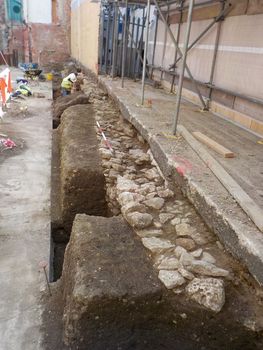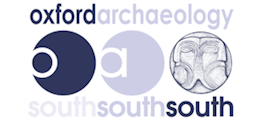Site Data from Archaeological Excavations at 114-119 St Aldates and 4-5 Queen Street, Oxford 2016
Oxford Archaeology (South), 2021. https://doi.org/10.5284/1088114. How to cite using this DOI
Data copyright © Oxford Archaeology (South) unless otherwise stated
This work is licensed under a Creative Commons Attribution 4.0 International License.
Primary contact
Oxford Archaeology (South)
Janus House
Osney Mead
Oxford
OX2 0ES
UK
Tel: 01865 263800
Fax: 01865 793496
Resource identifiers
- ADS Collection: 4099
- DOI:https://doi.org/10.5284/1088114
- How to cite using this DOI
Introduction

This collection comprises site data (reports, site images, finds data site records and a site drawing) from archaeological excavations undertaken at 114-119 St Aldates and 4-5 Queen Street, Oxford by Oxford Archaeology between March and October 2016. The excavations shed light on some of the oldest and grandest parts of the medieval city.
The earliest evidence comprised sunken floors and pits that date to the mid/late Saxon period. It is possible that the evidence pre-dates the Saxon burh, which was founded by the early tenth century. A series of later rubbish pits dating to the late Saxon and early Norman period was cut through this horizon. The pits contained pottery and bone fragments, denoting general rubbish, as well as faecal material and the raked-out fuel waste from ovens, fires and hearths.
A stone-lined latrine cut through the rubbish pits. The latrine contained a rich assemblage of twelfth- or early thirteenth-century pottery, animal bone and other domestic material. The well-constructed nature of the feature suggests that it was associated with a house of a wealthy individual. It is known that during this period part of the site was in Jewish ownership, and this is supported by the faunal remains and organic residues on pottery.
A stone-built structure, part of a below-ground cellar, lay to the east of the latrine. The later fills of the cellar contained a small assemblage of fifteenth or sixteenth-century pottery, which almost exclusively comprised drinking vessels that are likely to have derived from one of several taverns that fronted St. Aldates and Queen Street. Another latrine, of seventeenth- and eighteenth-century date contained an assemblage of pottery, vessel glass, clay pipes and fruit remains that identify wealthy inhabitants here during this time. There was further remodelling of the area in the subsequently, but these levels were poorly preserved owing to modern truncation.





